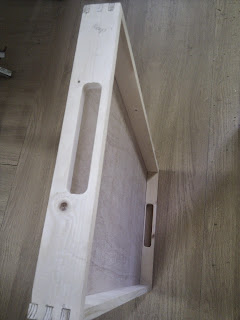Aluminium Woodrat Mortice Rail
The butler's tray project highlighted a lack of my ability to use the woodrat for mortising. Although the wooden mortice rail is useful for some work, cutting the handle holes for the butler's tray would be very difficult using it. Woodrat have an MR4 mortice rail which is an aluminium channel with some holes cut in it.
I have a milling machine, so decided to make one rather than buy one.
After a trip or two to Metal Supermarket in Southampton, I had a one metre length of 2mm aluminium channel 90mm wide and 50mm deep. The dimensions are approximate as the channel was sized in imperial units.
IU drilled two holes in the back face at the spacing that the clamps holes on the woodrat are set at, these are used to fix the rail to the woodrat. Two countersunk M8 screws do this, so the hols need to be countersunk. I cut two holes on the front face so that I could do this, this appears to be the same on the MR4. The tool passes through the front face through these holes.
Some tapped M8 holes at the front of the rail are used to clamp the workpiece in the rail. The MR4 has handles for this, I'm using bolts for now.
The countersunk screw and access hole can be seen here:
You can see the clamp bolts here and the clearance between the rail and the base plate of the woodrat. This gap may be a bit large, for some jobs the rail would be better arranged if it was higher. I may create another set of countersunk holes that are lower:
One of the advantages of making the rail is that I can add more holes here and there as needed, without feeling bad about cutting into an expensive MR4 rail...


































